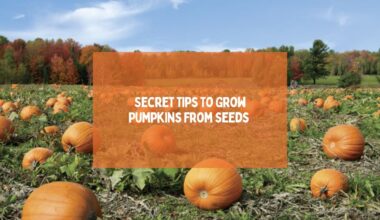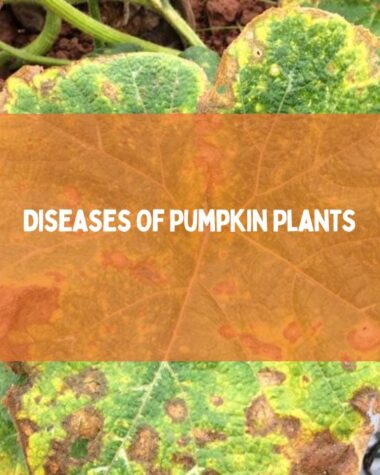Growing giant pumpkins can be a fun and rewarding experience, but it also requires careful planning and attention to detail. Large pumpkins are typically varieties specifically bred to grow to impressive sizes, sometimes weighing several hundred pounds.
These giant pumpkins are often entered into competitions and fairs, where growers compete to see who can grow the largest pumpkin. Growing large pumpkins requires a lot of care, attention, and dedication, but it can be a rewarding and fun experience for those who enjoy gardening and competition.
In this article, you will learn about how to care for and grow large pumpkins. With the right care and attention, you can see how pumpkins grow large to impress your friends and family!
8 Secrets To Growing Large Pumpkins
Growing large pumpkins can be a fun and rewarding challenge. By following these ways, you can increase your chances of growing a large, healthy pumpkin.
1. Start With The Right Seeds
To grow large pumpkin seeds, it’s important to start with the right seeds. Choose a variety of pumpkin that is known for producing large fruits. Look for seeds from reputable suppliers. Make sure to read reviews and check the seller’s reputation to ensure that you’re getting high-quality seeds.
Check the seed packet for information on the plant’s growing requirements. Make sure that the variety you choose is suitable for your climate and growing conditions. Consider starting the seeds indoors to give them a head start.
Sow the seeds in biodegradable pots filled with seed-starting mix and keep them in a warm, well-lit area until it’s time to transplant them outdoors. By starting with the right seeds, you’ll be setting yourself up for success in growing large pumpkins.
Related Reading
2. Prepare The Soil
Preparing the soil is a critical step in growing large pumpkins. Pumpkins need at least 6 hours of direct sunlight per day, so choose a spot in your garden that gets plenty of sun.
Use a soil test kit to check the pH level of your soil. Pumpkins prefer slightly acidic soil with a pH between 6.0 and 6.8. If your soil is too acidic, add lime to raise the pH level. If it’s too alkaline, add sulfur to lower the pH.
Use a garden tiller or hand cultivator to loosen the soil to a depth of at least 12 inches. After planting, add a layer of mulch around the base of the plants to help retain moisture and suppress weed growth.
3. Plant The Seeds In The Soil
Planting the seeds properly is essential for growing large pumpkins. Pumpkins prefer warm soil, so wait until after the last frost date in your area before planting. In most areas, this will be in the late spring or early summer.
Pumpkins need a lot of room to grow, so choose a spot in your garden with plenty of space. Plant the seeds about 1 inch deep and 4 to 6 feet apart. Plant two or three seeds per planting hole, as not all seeds may germinate.
Once the seeds have sprouted and you can see which ones are growing strongest, thin out the weaker seedlings so that only one plant remains. Keep the soil consistently moist, but not waterlogged, until the seeds have germinated.
Once the seedlings have emerged, water deeply once or twice a week, depending on weather conditions. Cover the seedlings with row covers or use other means to protect them from pests and harsh weather conditions.
4. Water Large Pumpkins Regularly
Watering regularly is essential for growing large pumpkins. Pumpkins need deep watering to encourage deep root growth. Water the plants deeply, so the water reaches the roots.
Consistent watering is key to growing healthy, large pumpkins. Avoid allowing the soil to dry out completely between waterings. Inconsistent watering can lead to uneven growth and a higher risk of diseases.
Watering in the morning allows the leaves to dry off during the day, reducing the risk of fungal diseases. Soaker hoses and drip irrigation systems are ideal for watering pumpkin plants because they deliver water directly to the soil without wetting the foliage, reducing the risk of fungal diseases.
5. Provide Fertilizer
Providing fertilizer is essential for growing large pumpkins. Pumpkins need a balanced fertilizer that contains equal amounts of nitrogen, phosphorus, and potassium. Look for a fertilizer labeled 10-10-10 or 20-20-20.
Mix a balanced fertilizer into the soil at planting time. This will provide the plants with the nutrients they need to get off to a strong start. Once the plants have begun to grow, side-dress them with a balanced fertilizer every 2-3 weeks.
Sprinkle the fertilizer in a circle around the base of the plants, about 6 inches away from the stem. If you prefer to use organic fertilizers, choose compost, well-rotted manure, or a balanced organic fertilizer. These will provide the plants with the nutrients they need while also improving soil health.
Over-fertilizing can lead to excessive foliage growth at the expense of fruit growth. Follow the fertilizer label instructions carefully to avoid applying too much fertilizer.
6. Prune The Vines
Pruning the vines is an important part of growing large pumpkins. Wait until the plant has developed several true leaves. Don’t prune the plant until it has developed several true leaves. This will ensure that the plant is strong enough to handle the stress of pruning.
The main vine is the largest stem that grows from the base of the plant. It’s important to leave this vine intact, as it is responsible for most of the plant’s growth. Side shoots are smaller stems that grow out of the main vine.
These shoots can sap energy away from the main vine and reduce fruit production. Use clean, sharp scissors to cut off any side shoots that grow from the base of the plant up to the first 2-3 feet of the main vine.
Once the plant has set several fruits, remove any new flowers or small fruits that appear. Train the main vine to grow in a straight line away from the plant. This will help the plant absorb more sunlight and nutrients, which can lead to larger fruits.
7. Protect The Pumpkins
Protecting pumpkins from pests and diseases is essential for growing large pumpkins. Row covers are lightweight fabrics that can be draped over the plants to protect them from pests and diseases.
Be sure to remove the covers once the plants begin to flower to allow pollination. Keep an eye out for pests such as squash bugs, cucumber beetles, and vine borers. If you spot any pests, remove them by hand or treat the plants with an organic insecticide.
Fungal diseases such as powdery mildew and downy mildew can damage pumpkin plants. Use an organic fungicide to control these diseases and avoid overhead watering, which can increase the risk of fungal infections.
Harvest pumpkins when they are fully mature to avoid damage from pests and diseases. Check the skin for hardness and make sure the stem is dry before harvesting. After harvesting, store pumpkins in a cool, dry place.
8. Harvest At The Right Time
Harvesting pumpkins at the right time is crucial for growing large pumpkins. Here are some tips for harvesting large pumpkins:
- Wait until the pumpkins are fully mature: Pumpkins should be left on the vine until they are fully mature. Look for a pumpkin that has reached its full size and has a deep, uniform color. The skin should be hard and not easily punctured with a fingernail.
- Check the stem: The stem of the pumpkin should be dry and brown. If the stem is green and pliable, the pumpkin is not yet mature and should be left on the vine.
- Use a sharp knife or pruners: To harvest the pumpkin, use a sharp knife or pruners to cut the stem, leaving a 3-4 inch stem attached to the pumpkin. Do not pull or twist the pumpkin, as this can damage the stem and reduce the storage life of the pumpkin.
- Cure the pumpkin: After harvesting, the pumpkin should be cured to increase its storage life. To do this, place the pumpkin in a warm, dry place for 7-10 days. This will allow the skin to harden and any minor cuts or scratches to heal.
Related Reading
- What Are the Causes of Deformed Cucumbers?
- How to Grow Delicious Aubergines in Your Polytunnel?
- How to Grow Tomatoes – The step-by-step Guide from Seeds to Harvest
Conclusion
Growing large pumpkins requires careful attention to several factors, including choosing the right seeds, preparing the soil, providing water and fertilizer, pruning the vines, and protecting the pumpkins from pests and diseases.
Provide regular water to the plants, making sure not to overwater. Use a balanced fertilizer that is high in phosphorus to promote fruit development. Use row covers, monitor for pests and diseases, and harvest the pumpkins at the right time to ensure the best possible storage life.
I hope this article will help you grow large pumpkins.
Thanks for Reading!







